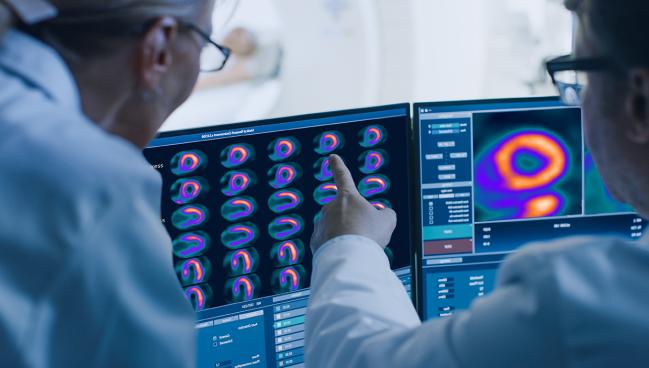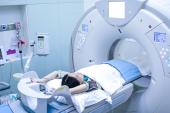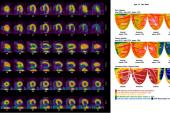FDA Approves First New PET Imaging Tracer for Cardiac Testing in Decades
With a much longer half-life than other radiotracers, flurpiridaz F-18 will boost patient access to PET imaging, one expert predicts.

Photo Credit: GE HealthCare
A new radioactive tracer for positron emission tomography (PET) myocardial perfusion imaging will soon be available in the United States, and it’s expected to facilitate substantial growth in such testing over the coming years.
Last week, the US Food and Drug Administration approved flurpiridaz F-18 (Flyrcado; GE HealthCare) for use during PET imaging under rest or stress to evaluate the presence of myocardial ischemia or infarction in adults with suspected or known coronary disease.
It’s the first new radiotracer approved for cardiac PET in decades. The two most commonly used tracers in the US, rubidium-82 and N-13 ammonia, were approved for clinical use in 1989 and 2000, respectively.
“It is really exciting for flurpiridaz to have its approval. It's something that we've been looking at and tracking for years now,” Lawrence Phillips, MD (NYU Langone Health, New York, NY), president of the American Society of Nuclear Cardiology (ASNC), told TCTMD. “The idea of a new radiopharmaceutical coming out that has excellent myocardial extraction, so the ability to have more of a linear relationship between the blood flow and perfusion, is really great for the sensitivity and specificity of the test.”
Moreover, flurpiridaz F-18 has a much longer half-life (about 110 minutes) than other PET tracers. That will allow for unit dosing, thus easing the use of PET imaging across a greater number of centers and ultimately increasing patient access to the test, which has been limited in many parts of the US.
“What this means is that people are going to be able to start doing PET earlier,” Phillips explained. “They're going to be able to collaborate closer, for example, with oncology partners, where often we'll see a PET scanner already in place. And they'll be able to have some time within the schedule to start doing cardiac and allow their programs to grow.”
People are going to be able to start doing PET earlier. Lawrence Phillips
The FDA’s approval was based on the results of two phase III trials. According to results published in 2020, the first showed that among patients with known or suspected CAD, PET imaging using flurpiridaz F-18 had superior discrimination of coronary disease (at least 50% stenosis) compared with technetium-99m-labeled single photon emission computed tomography (SPECT), with improvements in image quality and diagnostic certainty.
AURORA, the second, again showed that among patients with suspected CAD, imaging with flurpiridaz F-18 significantly improved the detection of CAD versus SPECT both overall and in key patient groups, including women and those with obesity.
Phillips noted the improved myocardial extraction with flurpiridaz F-18 compared with other tracers will enhance the validity of the tests. “[This] is going to translate into even greater collaboration between nuclear cardiologists and interventional cardiologists when trying to decide which vessels need to be intervened on,” he predicted. “It's also going to [allow] greater collaboration between referring physicians and their nuclear cardiology colleagues because of confidence in the test results.”
There will be a learning curve when it comes to interpreting the higher-quality images produced using flurpiridaz F-18, Phillips said, noting that ASNC has been working on ways to help clinicians incorporate new innovations like this tracer into their practices.
“When it comes to flurpiridaz specifically, we know that there's a difference in the reading approach, and so we're putting together a whole portfolio of educational materials so the nuclear cardiology community can be uptrained and feel confident in their interpretations,” he said.
GE HealthCare said the tracer will be available in the first US markets starting early next year. It’s unclear how it will be priced and whether its advantages—like the ability to use unit dosing—will make up for a potentially higher cost.
“In so many patients, cardiac PET is a go-to test to give the diagnostic information that's needed, and my hope is that the pricing is going to be appropriate and not be a limitation to the accessibility,” Phillips said.
In the coming years, this approval is likely to have an impact across multiple areas of cardiology, he predicted.
“We're going to see the expansion of perfusion PET. We're going to see people and practices investing in that as one of their imaging modalities. And that's going to allow us to expand our diagnostic prowess, not just in perfusion imaging, but everything else we get from PET,” Phillips said. “And so I think it's an exciting time. The nuclear cardiology community is very excited about this. And . . . it's really good for our patients.”
Todd Neale is the Associate News Editor for TCTMD and a Senior Medical Journalist. He got his start in journalism at …
Read Full BioSources
US Food and Drug Administration. FDA approves imaging drug for evaluation of myocardial ischemia and infarction. Published on September 27, 2024. Accessed on: October 2, 2024.
Disclosures
- Phillips reports no relevant conflicts of interest.





Comments